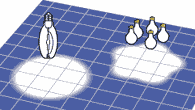| |
Characteristics
The unique characteristics
of metal halide lighting provide high performance such as:
Long Life
Metal halide lamps have an average life of 15,000-20,000+ hours,
more than ten times that of incandescent.
Better
Light Quality
The output of metal halide lamps is closer to natural sunlight than
most other light sources. People prefer white light because of better
visual acuity, even at lower light levels.
Designable
Color
Metal halide lamps can be designed to produce almost any color temperature
desired, from 2700K to 20,000K. Specialty colors, including blue,
green, aqua and pink, can also be produced.
back
to top
Excellent
Color Rendering
Metal halide offers excellent color rendering, with a 65-90 CRI
(color rendering index).
Compact Size
Metal halide generates high light levels from a compact light source.
This allows for smaller, more controllable luminaires.
Versatility
Metal halide lamps are relatively unaffected by ambient temperature,
equally suited for indoor or outdoor use. Extensive style and wattage
options allow for many applications.
High Efficiency
Metal halide lamps generate 65-115 lumens per watt, more than incandescent,
fluorescent or mercury vapor lamps. (see chart at right)
Positive
Environmental Impact
Since metal halide lamps deliver light more efficiently than incandescent,
widespread acceptance of the technology has a positive effect on
air quality and the environmental waste stream. Lower electrical
power generating requirements means less air pollution. Efficient
long-life systems mean less landfill waste.

A more efficient
light source also means less waste.
back
to top
|
|
Technology
Goes Head-to-Head
MH vs. Incandescent
A 100 watt metal halide lamp provides five times the lumen output
of a 100 watt incandescent lamp, and will last 20 times longer.
Although incandescent has a low initial lamp cost, metal halide
has lower total operating cost over life.

Five times more efficient than incandescent
MH vs. Mercury
Vapor Mercury lamps have long life, but are not as energy efficient
as metal halide, producing only 35-58 lumens per watt. Their limited
blue-green light spectrum has a lower CRI than metal halide.

Metal halide generates light closer to sunlight than any other
HID light source.
MH vs. HPS
While HPS lamps offer long life, they do not deliver the same light
quality as metal halide. Because of their dominant sodium content,
HPS lamps yield strong yellow light (2200K) and have a very poor
CRI of 20-25. The full spectrum light of metal halide has a much
higher CRI.
back
to top
|
|
MH vs. Fluorescent
Fluorescent lamps are harder to direct because of their larger size.
One 100 watt metal halide lamp produces the same light as three
48" high output T8 fluorescent lamps. Metal halide lamps also tolerate
a wider operating temperature range. Fluorescents are often limited
to temperature-controlled indoor applications. T8 fluorescent lamps
perform optimally at approximately 77¡F (25¡C), degrading measurably
as temperature varies. T5 lamps perform similarly, but peak at 95¡F
(35¡C).
Wider Range
of Applications
Specifiers can now select from a broad variety of lamp types and
wattages to suit almost any application. Metal halide lighting is
used today indoors and out, for industrial, commercial, retail and
municipal spaces. Popular for sports facilities, and site lighting,
it is increasingly found in supermarkets, big box retail, offices
and lobbies.
 The
Most Advanced Technology The
Most Advanced Technology
A major advancement in metal halide lighting was the introduction
of VentureÕs revolutionary Uni-Form¨ pulse start system. This second
generation technology holds the future for metal halide. Uni-Form
pulse start systems offer up to 50% more lumens per system watt
than do traditional metal halide lamps and ballasts. Its capabilities
continue to improve. Recently, Venture became the only manufacturer
to offer Uni-Form pulse start lamps optimized for horizontal-only
operation. Our high wattage e-Lampª, designed to operate on high
frequency electronic ballasts with built-in dimming down to 35%
power, is another unique new high performance product. New developments
will soon bring better lumen maintenance and even more wattage options
for specifiers.
back
to top
|
|

